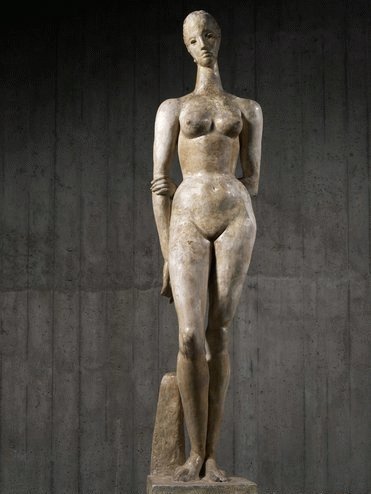Leaving Rodin behind?
dal 8/3/2009 al 30/5/2009
Segnalato da
Auguste Rodin
Wilhelm Lehmbruck
Constantin Brancusi
Henri Gaudier-Brzeska
Alexander Archipenko
Aristide Maillol
Emile Antoine Bourdelle
Manuel Martinez Hugue
Albert Bartholome'
George Minne
Otto Guttfreund
Elie Nadelman
Catherine Chevillot
Laure de Margerie
Christoph Brockhaus
Katharina Lepper
8/3/2009
Leaving Rodin behind?
Musee d'Orsay, Paris
Sculpture in Paris, 1905 - 1914. The main part of the exhibition looks at the experiments of a generation of artists into volume and structure, focusing on pivotal subjects like the torso - from Bourdelle to Brancusi, including Gaudier-Brzeska and Archipenko - the curled figure - based around Maillol's La Mediterranee - the head - from Manolo to Nadelman and Brancusi - and the kneeling figure, represented by the sculptures of Minne, Bartholome', Lehmbruck, Archipenko, Brancusi and Guttfreund.

This exhibition has been organised by the Musée d’Orsay, the Réunion des Musées Nationaux
and the Fundaciòn cultural Mapfre, Madrid, with the special collaboration of the Stiftung
Wilhelm Lehmbruck Museum, Duisburg.
It is part of the North Rhine-Westphalia Artention cultural season 2008/2009 and is supported
by the state of North Rhine-Westphalia.
Around 1900, in sculpture, there was a pressing desire to find a new formal approach: “It seems that a
modern kind of statuary is still to be created.” Sculptors aspired to rediscover the laws of their art: “We
have to discover the ruling principle, through a lifetime of often desperate effort”, Bourdelle would say.
Maurice Denis pointed out the predominant “feeling for form, for the beauty of line, for geometric
perfection” in Maillol’s work, for his only guide was “an exquisite, instinctive, impulsive feeling for
form”, moving closer to “the sphere and the cylinder”. The work of the German sculptor Lehmbruck
picked up this theme: “Is not an intelligent observation of a physical law, inviting comparisons with the
heavier-than-air craft, worth more than unbridled, sentimental inventiveness that nothing can codify and
that, all too often, goes against the essential properties of the material?” Lehmbruck’s ideas are
symptomatic of this whole generation, who opposed Rodin, and who were never classed as avant-garde,
Fauvism and Cubism being considered at the time as, first and foremost, movements in painting.
At that time, artists from all over Europe were in Paris, revealing in their respective styles, the same
preoccupations. Minne arrived for the first time in 1891. In 1900, Hoetger, Gonzalez and Clara moved
to the French capital, joined by Manolo in 1901. Casanovas, Brancusi, Picasso and Nadelman set up
there in 1904; Gargallo stayed on a number of occasions in 1903-1904, 1907 and 1912; and Epstein
lived there between 1902 and 1905. In 1906, Modigliani arrived; in 1908, Archipenko and in 1909,
Zadkine, Freundlich and Gutfreund. Lehmbruck lived there from 1910 to 1914, as did Haller and, in
1911, Ernesto De Fiori. Their paths all crossed in Paris and they all exhibited there. For ten years, the
city was the crucible in which new ideas about sculpture were exchanged and intermingled in
experimental variations that challenged conventional categories, only created after 1918. The idea that
contemporary sculptors were creating modern sculpture was clearly evident in international exhibitions
like the Sonderbund in Cologne in 1912, and the Armory Show in New York in 1913.
The first section of the exhibition looks at the end of Rodin’s influence – Joseph Bernard, Lehmbruck,
Bourdelle, Matisse, and Duchamp-Villon, followed by the great change of 1905, with the figures of
Bourdelle, Hoetger and Maillol. The main part of the exhibition looks at the experiments of this
generation into volume and structure, focusing on pivotal subjects like the torso – from Bourdelle to
Brancusi, including Gaudier-Brzeska and Archipenko – the curled figure – based around Maillol’s La
Méditerranée – the head – from Manolo to Nadelman and Brancusi – and the kneeling figure,
represented by the sculptures of Minne, Bartholomé, Lehmbruck, Archipenko, Brancusi and Guttfreund.
There is also a section looking at relief sculpture.
When war broke out, everything was turned upside down. Since before 1914, there had been a
noticeable shift in artistic preoccupations, and after 1919, the opposing forces were redistributed in a
different way: Gaudier-Brzeska died in 1915, Duchamp-Villon in 1918, Archipenko left Paris for Berlin,
then moved permanently to America in 1923, as did Nadelman in 1914. Bartholomé died in 1928,
Bourdelle in 1929, and Bernard in 1931 after a long illness that forced him to give up all creative work.
Brancusi and Maillol came to symbolise opposing trends. Lehmbruck’s final works, from 1914 to 1919,
were not characteristic of his previous work or of German Expressionism, and were almost a symbol of
the end of a world.
Curators:
Catherine Chevillot, commissioning curator, chief curator at the Musée d’Orsay
Paris, Musée d'Orsay
Laure de Margerie, archivist
Duisburg, Stiftung Wilhelm Lehmbruck Museum – Zentrum Internationaler Skulptur
Prof. Dr Christoph Brockhaus, director
Dr Katharina Lepper, curator
Publications
Exhibition catalogue, Musée d'Orsay / MAPFRE Foundation / Editions Hazan. 42 euros. 332 pages.
Around the exhibition
In-house exhibitions
Sculpture drawings from Chapu to Bourdelle (10 March – 31 May 2009), Level 0, room 8.
Study day
Cosmopolitan Paris: the milieu of sculpture from 1905 to 1914
Thursday 12 March 2009, 9am – 5pm, in partnership with the French National Institute for the
History of Art
In partnership with the National Institute for the History of Art (Paris), with the participation of:
Ilaria Cicali, Uwe Fleckner, Valerie Fletcher, Silvia Garinei, Béatrice Joyeux-Prunel, Aline Magnien,
Pierre-Michel Menger, Peter Read, Paul-Louis Rinuy, Inga Rossi-Schrimpf and Malgorzata
Szelagowska.
Media Partners: France Info, Paris Première, Le Figaro
Communication Department: Amélie Hardivillier: +33 (0)1 40494856 – amelie.hardivillier@musee-orsay.fr
Press contact: Christine Cuny: +3 (0)1 40494996 – christine.cuny@musee-orsay.fr
Image: Wilhelm Lehmbruck, Grande figure debout© Museum Wilhem Lehmbruck / Photo Fondation MAPFRE, Christian Baraja
Musee d'Orsay Paris
62, rue de Lille 75343 Paris Cedex 07
Access: through the main entrance, 1, rue de la Légion d'Honneur, 75007 Paris
Opening times: daily except Monday, 9.30am to 6pm, late night opening on Thursdays until 9.45pm
Admission: Museum entrance ticket: full rate: €8; concessions: €5.50



